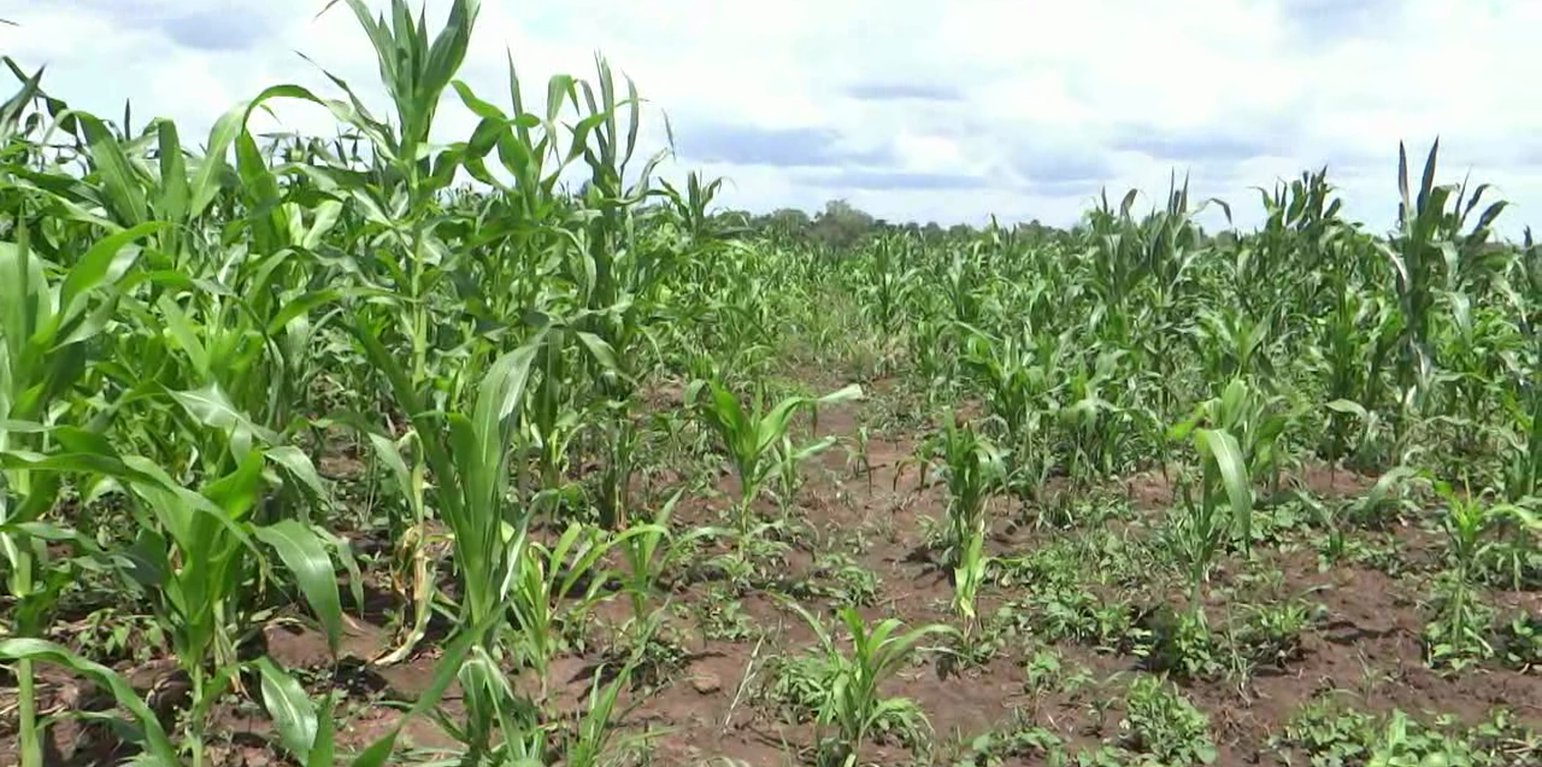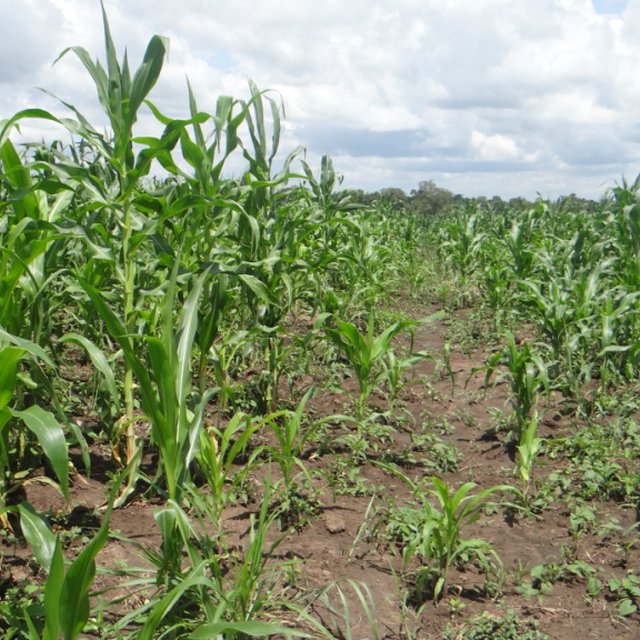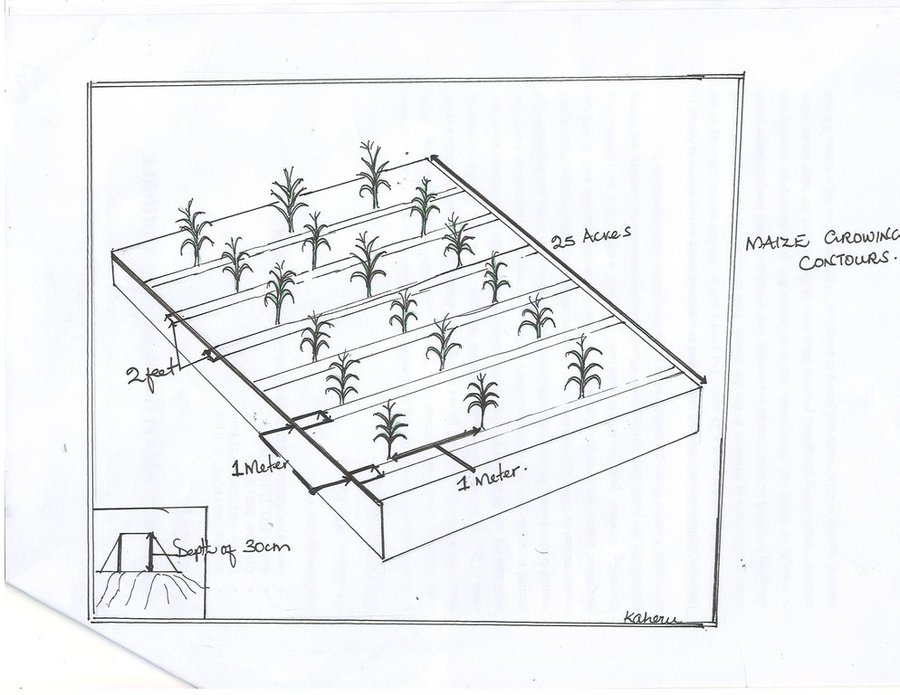



Improved Maize variety (Longe 10) is popularly grown in Northern Uganda due to its high yielding ability. Northern Uganda has a generally flat landscape although along the river banks it is slopy with high risk of soil erosion. This has motivated the land user to grow his maize along the slope using contour ploughing which is a sustainable land management practice. Contour farming is a practice of ploughing and/or planting across a slope following its elevation contour lines. The contour lines create a water break which reduces rill and gully forms of soil erosion in case of heavy storms. The water break allows more time for more water to percolate/sink into the soil, thus reducing the amount of water left to run off the surface. Northern Uganda has a tropical savanna climate with one growing season. Rainfall is usually moderate ranging from 1000-1500 mm per annum and sometimes occurs with heavy storms. Rainfall is received from April to November with a dry spell in June and July which affects crop growth.
The maize was grown for commercial purposes in a 25 x 25 acres of land on contour lines with the aim of controlling soil erosion, and increase plant nutrients, soil moisture, productivity and household income. The maize is planted along the contour lines at a spacing of 30 cm between the maize plants and of 1 meter between the rows that runs across the contour field. Holes for planting maize are dug at a depth of 30 cm along the contours with four maize seeds planted per hole and covered with soil immediately since the contours creates a water break which reduces the formation of rills and gullies during heavy water run-off which is a major cause of soil erosion.
The activities involved in establishing such a technology include clearing the field during the dry season in March and second ploughing in early April to alter the soil and allow proper decomposition of the grass and also creating contours during planting in early April at the onset of the rainy season. Weeding is done twice, first two weeks after maize germination in late April, and lastly in June.
Inputs needed to establish the technology include ox-plough, hoes, and pangas used to clear the field. Inputs for maintaining the technology include hoes for weeding the maize crop and also checking that the contours are not destroyed by the run-off.
The technology is liked because it is good at controlling soil erosion on the gently sloping field, increases plant nutrients and soil moisture, and increases productivity. But it is disadvantageous when contours collapse which is accelerating the speed of surface run-off.

地点: Gulu district, Northern Uganda., 乌干达
分析的技术场所数量: 单一场所
技术传播: 均匀地分布在一个区域 (approx. < 0.1 平方千米(10 公顷))
实施日期: 不到10年前(最近)
介绍类型



技术规范
作者:Betty Adoch.
Contours are created on a gentle slope using ox-plough. Maize holes are dug at a depth of 30 cm and a spacing of 30 x 30 cm. The distance between the contours are 1 x 1 meter. The contours are helpful in improving infiltration rates and controlling soil erosion.
|
|||||||||||
| 对投入进行具体说明 | 单位 | 数量 | 单位成本 (UGX) | 每项投入的总成本 (UGX) | 土地使用者承担的成本% |
| 劳动力 | |||||
| Clearing land | days | 30.0 | 5000.0 | 150000.0 | 100.0 |
| Ox-ploughing | days | 5.0 | 40000.0 | 200000.0 | 100.0 |
| 设备 | |||||
| Ox-plough | pices | 5.0 | 20000.0 | 100000.0 | 100.0 |
| Hoes for digging left over grass | pices | 10.0 | 12000.0 | 120000.0 | 100.0 |
| Pangas for cutting tress in the field | pices | 10.0 | 12000.0 | 120000.0 | 100.0 |
| 植物材料 | |||||
| Seedlings | kgs | 150.0 | 6000.0 | 900000.0 | 100.0 |
| 技术建立所需总成本 | 1'590'000.0 | ||||
| 对投入进行具体说明 | 单位 | 数量 | 单位成本 (UGX) | 每项投入的总成本 (UGX) | 土地使用者承担的成本% |
| 劳动力 | |||||
| Weeding | days | 10.0 | 5000.0 | 50000.0 | 100.0 |
| Thining | days | 10.0 | 5000.0 | 50000.0 | 100.0 |
| 技术维护所需总成本 | 100'000.0 | ||||
SLM之前的数量: low
SLM之后的数量: high
SLM knowledge gained
SLM之前的数量: low
SLM之后的数量: high
SLM knowledge acquired
SLM之前的数量: low
SLM之后的数量: high
proper method of farming leading to increased yield and income through SLM knowledge
SLM之前的数量: low
SLM之后的数量: high
knowledge of SLM leading to increased yield
SLM之前的数量: low
SLM之后的数量: high
proper method of farming along a gentle slope using contours
SLM之前的数量: low
SLM之后的数量: high
water is collected in the trenches between the contours increasing the infiltration rates and leading to high moisture content in the soil.
SLM之前的数量: high
SLM之后的数量: low
the contours reduce the high rate of surface run-off.
SLM之前的数量: low
SLM之后的数量: high
high soil moisture due to high rate of infiltration along contour lines
SLM之前的数量: high
SLM之后的数量: low
the low rate of soil erosion along the contours reduces sediment deposition downstream.